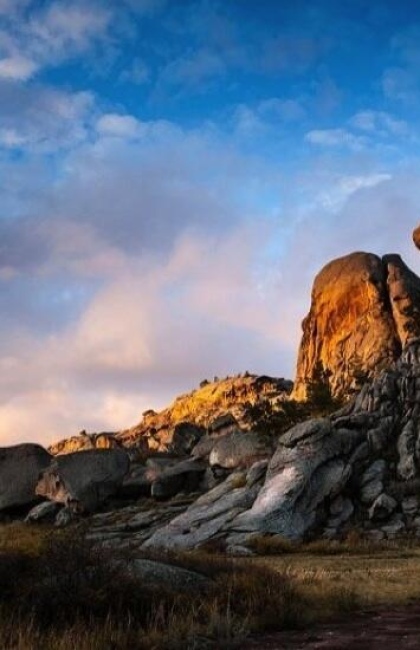Begazy Necropolis
The Kyzylarai mountain range is remarkable not only for its rugged beauty and pristine nature, but also for its ancient monuments. Among them, the Begazy Necropolis holds a special place. This late Bronze Age burial complex, dating to the Begazy-Dandybai culture (12th-8th centuries BC), is considered a rare testament to the first signs of “urban” civilization emerging in the steppe.
The Bronze Age City of the Dead
The necropolis is distinguished by monumental burial structures built from massive granite slabs. Some stand as tall as a person or even higher, reaching up to 3.5 meters. Archaeologists call them “mausoleums.” However, they differ from traditional mausoleums and burial mounds typical of steppe nomads.
The complex consists of dozens of tombs. At its center were the graves of leaders, priests, and other elite figures, while more modest burials were arranged around them. Even in that distant era, the layout reflected the rise of social hierarchy and property inequality.
When first discovered, the necropolis lay in ruins, with stone slabs scattered across the steppe. Later, archaeologists restored the site, reassembling the blocks into structures resembling burial mounds. This is how visitors see the Begazy Necropolis today.

Traces of a Settled People
The necropolis did not stand alone, settlements once existed nearby. Excavations have uncovered ceramics, bronze tools, jewelry, and evidence of advanced animal husbandry and agriculture. These finds show that the Begazy-Dandybai people were not mere nomads, but a settled society with developed crafts and an organized economy.
In the surrounding area, traces of ancient mining are still visible: ore pits, waste rock, and slag, pointing to active extraction of copper, tin, and later iron. Metallurgy played a central role in their culture.
The Begazy Necropolis is more than just an ancient cemetery, it is a kind of “stone archive” that records the transition from tribal organization to statehood.
How to Get There?
The necropolis lies about 40 km (25 mi) southeast of the village of Aktogay in the Karaganda Region. From Karaganda, take the M-36 highway to Aktogay, and then continue along steppe roads. Since there are no signs, first-time visitors are advised to go with a local guide or resident.
The nearest place to stay overnight is the village of Shabanbai Bi, where many locals rent rooms to tourists.
Other tourist attractions near the necropolis:
- Kyzylarai Mountains
- Mount Aksoran
- Bektau Ata Tract
- Northern Shore of Lake Balkhash
- Kent Mountains






_420x650_4ab.jpg)